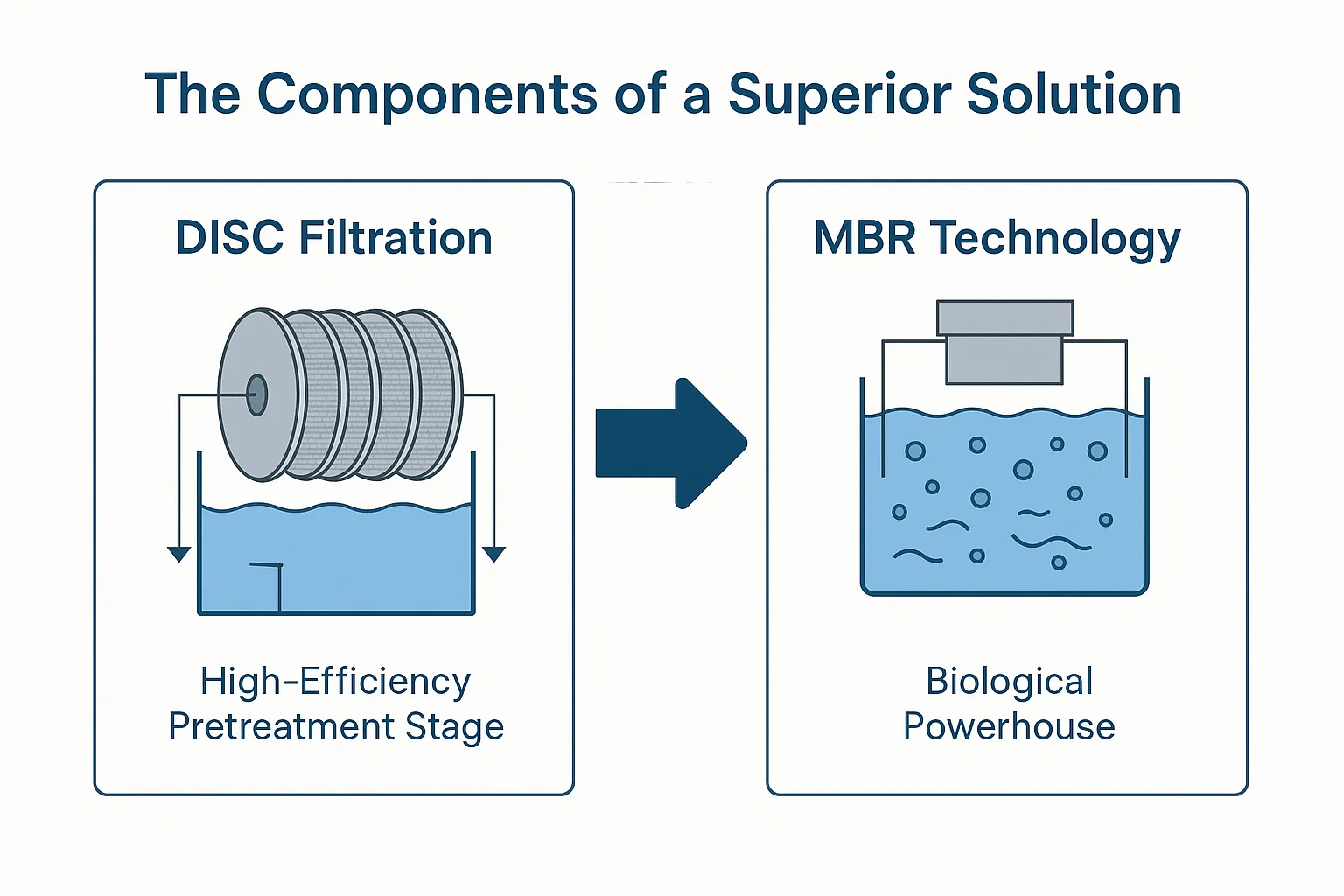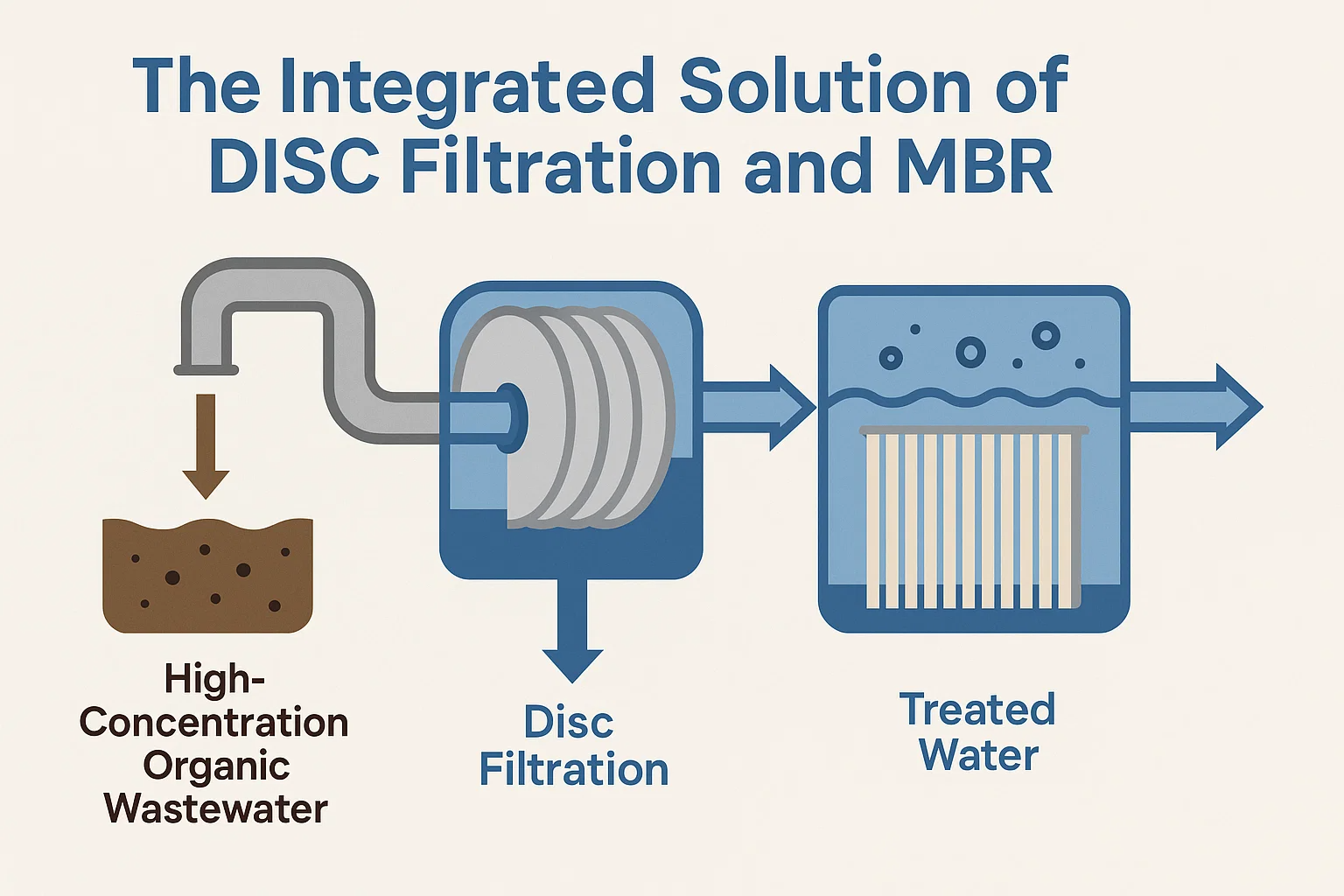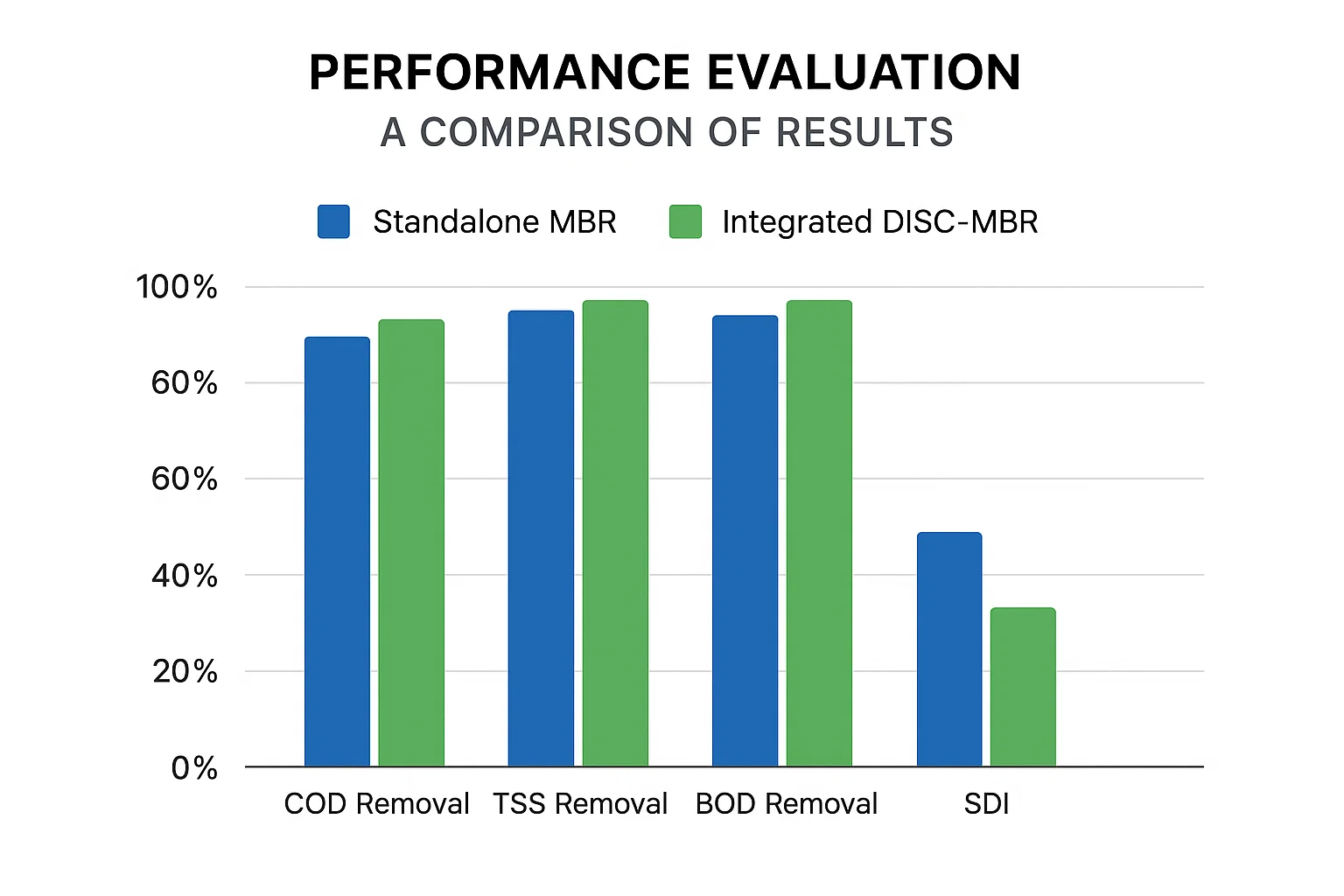 +86-15267462807
+86-15267462807
Breaking Down the Challenge: The Integrated Solution of DISC Filtration and MBR for High-Concentration Organic Wastewater
In today's industrial landscape, the effective treatment of high-concentration organic wastewater is a critical challenge. Industries such as food and beverage, chemicals, and pharmaceuticals generate effluent with extremely high levels of Chemical Oxygen Demand (COD), Biological Oxygen Demand (BOD), and Total Suspended Solids (TSS). Discharging this wastewater without proper treatment poses severe environmental risks and violates increasingly strict regulatory standards.
For years, Membrane Bioreactor (MBR) technology has been a go-to solution, celebrated for its ability to produce superior effluent quality and its compact footprint. However, when faced with high-concentration wastewater, a standalone MBR system often struggles. The high solids load can lead to rapid membrane fouling, increased operational costs, and reduced system stability.
This is where a powerful synergy comes into play. By integrating DISC filtration as a robust pretreatment step, we can create a two-stage solution that addresses the limitations of a single technology. The DISC filter acts as a frontline defense, efficiently removing a significant portion of suspended solids before the water ever reaches the MBR membranes.
This article argues that the integration of DISC filtration and MBR offers a revolutionary "dual-protection" solution for high-concentration organic wastewater. This combined approach not only solves the inherent challenges of a standalone MBR system but also achieves a perfect balance of efficiency, effluent quality, and long-term sustainability. We will explore the principles of each technology, the undeniable benefits of their integration, and real-world performance data that validates this innovative approach.
To overcome the challenges posed by high-concentration organic wastewater, we must leverage advanced technologies that are both powerful and complementary. Our integrated solution is built on two key components, each with its own unique advantages.

DISC filtration is a modern, compact filtration technology designed for effective solid-liquid separation. Unlike conventional deep-bed filters, which rely on a thick layer of media, DISC filters use a series of vertical, rotating discs covered with fine-mesh filter cloth. The wastewater flows from the inside of the discs to the outside, and suspended solids are trapped on the surface of the filter cloth.
This simple yet effective design provides several critical advantages:
Superior Solids Removal: DISC filters can achieve a very high removal rate of Total Suspended Solids (TSS), often exceeding 90%. This precision is a direct result of the fine pore size of the filter cloth, which can be tailored to specific applications.
Compact Footprint: The vertical disc configuration allows for a large filtration area within a minimal footprint, making it ideal for facilities with limited space.
Automated and Low-Maintenance: The system is fully automated. When the suspended solids build up on the filter cloth, a differential pressure sensor triggers a self-cleaning cycle. High-pressure jets automatically backwash the discs, with the process water often supplied from the filtered effluent itself, minimizing water waste.
Consistent Performance: The continuous cleaning and self-adjusting operation ensure stable and consistent effluent quality, even with fluctuating influent loads.
The MBR system represents the pinnacle of modern biological wastewater treatment. It seamlessly combines a biological treatment process (like an activated sludge system) with an ultrafiltration or microfiltration membrane separation process. Instead of a traditional clarifier, membranes are used to physically separate the treated water from the mixed liquor, retaining all biomass and suspended solids within the reactor.
This separation method unlocks significant benefits for high-concentration wastewater treatment:
Exceptional Effluent Quality: MBR membranes act as an absolute barrier, producing an effluent that is virtually free of suspended solids, bacteria, and pathogens. The treated water is of such high quality that it can be safely reused for many non-potable applications.
Smaller Footprint: By eliminating the need for a large secondary clarifier, MBR systems require significantly less space—often up to 50% less than conventional systems.
High Biomass Concentration: The ability to retain biomass allows the system to operate at a much higher Mixed Liquor Suspended Solids (MLSS) concentration. This means the biological process is more efficient and can handle a higher organic load, making it exceptionally effective for breaking down high concentrations of COD and BOD.
Enhanced Stability: A higher MLSS concentration also gives the system a greater buffering capacity, allowing it to withstand sudden shocks from organic or hydraulic loads.
While both DISC filtration and MBR technology are powerful in their own right, their true potential is unlocked when they are combined into a single, cohesive system. By positioning the DISC filter as a dedicated pretreatment stage, we can create a robust and highly efficient solution that overcomes the individual limitations of each technology.

The integrated system operates on a straightforward and highly effective principle.
Primary Screening: Wastewater first passes through a coarse screen to remove large solids.
DISC Pretreatment: The pre-screened wastewater then flows into the DISC filtration unit. Here, the fine-mesh filter cloth captures the majority of the Total Suspended Solids (TSS) and other colloidal matter. The DISC filter continuously backwashes itself to maintain optimal performance.
MBR Biological Treatment: The pre-filtered wastewater, now significantly lower in TSS, flows into the MBR reactor. The biological process efficiently breaks down the high concentrations of COD and BOD.
Membrane Separation: The MBR's submerged membranes then perform the final solid-liquid separation, producing high-quality effluent that is virtually free of suspended solids and bacteria.
This integrated approach provides a host of benefits that a standalone MBR system simply cannot match, especially when treating high-concentration organic wastewater.
Membrane fouling is the single greatest operational challenge for MBR systems. The primary cause of this fouling is the accumulation of suspended solids, colloids, and extracellular polymeric substances (EPS) on the membrane surface. By using DISC filtration to remove a significant portion of these foulants upfront, we dramatically reduce the load on the MBR membranes. This leads to:
Less frequent chemical cleaning, which saves on chemical costs and minimizes the risk of membrane damage.
Lower trans-membrane pressure (TMP) buildup, allowing the system to operate at a stable flux for longer periods.
A significantly longer membrane lifespan, reducing the frequency and cost of expensive membrane replacements.
High-concentration industrial wastewater is often subject to sudden fluctuations in load or composition. A standalone MBR can struggle to cope, leading to process instability. The DISC filter acts as a crucial buffer. It absorbs these shocks by consistently removing a large portion of the solids before they reach the MBR, ensuring the biological process and membrane separation remain stable and efficient.
With the membranes better protected and the biological process more stable, the integrated system can consistently achieve superior performance. The final effluent is exceptionally clean, with COD and BOD removal rates often exceeding 95%. This high-quality water is suitable for direct discharge or, more importantly, can be reused for various industrial or agricultural applications, contributing to water conservation and sustainability goals.
The theoretical benefits of the integrated DISC-MBR system are validated by its superior performance in real-world applications. By focusing on key performance indicators (KPIs), we can clearly demonstrate the advantages of this combined approach over a standalone MBR system.

When evaluating the effectiveness of a wastewater treatment system, we look at several critical metrics. The integrated DISC-MBR system consistently excels in these areas:
COD Removal (Chemical Oxygen Demand): This metric measures the total amount of organic matter in the wastewater. An integrated DISC-MBR system routinely achieves COD removal rates exceeding 95%, ensuring the final effluent meets stringent discharge regulations.
TSS Removal (Total Suspended Solids): The DISC filtration stage is highly effective at removing TSS, and the MBR membranes provide a final, absolute barrier. This two-step process results in a near-perfect TSS removal rate, often over 99%.
BOD Removal (Biological Oxygen Demand): The high biomass concentration within the MBR reactor, combined with a stable operating environment, allows for exceptional biological degradation. BOD removal rates typically exceed 98%.
SDI (Silt Density Index): This is a key indicator of water quality, particularly for reuse applications. The low SDI of the final effluent from an integrated DISC-MBR system makes it ideal for direct reuse in various industrial processes or irrigation without requiring further tertiary treatment.
The most compelling evidence for the integrated approach comes from a direct comparison. Pilot studies and full-scale implementations have consistently shown the integrated system outperforms a standalone MBR when treating high-concentration organic wastewater.
| Performance Metric | Standalone MBR | Integrated DISC-MBR |
| Membrane Fouling Rate | High (frequent cleaning needed) | Low (cleaning frequency reduced by 50%+) |
| Trans-Membrane Pressure (TMP) | Rapidly increases | Stable, slow increase |
| Average Membrane Lifespan | 5-7 years | 7-10+ years |
| Effluent TSS (mg/L) | < 5 | < 1 |
| Energy Consumption | Higher (more aeration for fouling control) | Lower (optimized aeration) |
| Chemical Costs | Higher (for frequent cleaning) | Lower (fewer cleaning cycles) |
Of course. Let's draft the next part of your article, focusing on the practical aspects of designing and operating an integrated DISC-MBR system. This section adds credibility by showing you've considered the real-world application of the technology.
While the integrated DISC-MBR system offers clear advantages, its successful implementation relies on careful design and optimized operational strategies. A one-size-fits-all approach is not effective; the system must be tailored to the specific characteristics of the wastewater it will treat.
The design of the integrated system is a multi-step process that requires a deep understanding of the project's unique requirements.
Wastewater Characteristics: The initial analysis of the wastewater's composition is paramount. This includes a detailed assessment of the concentration and variability of COD, BOD, TSS, pH, and temperature. For example, a high concentration of fats, oils, and grease (FOG) may require a finer filter pore size in the DISC unit or an upstream DAF (Dissolved Air Flotation) step for effective removal.
Treatment Goals: The final design is heavily influenced by the required effluent quality. Is the goal direct discharge to a sensitive waterway, or is it for high-quality water reuse? The answer dictates the specific membrane pore size and overall system capacity.
Space and Site Constraints: The compact nature of both DISC and MBR technologies is a key benefit, but site-specific layouts still need to be optimized. The vertical arrangement of the DISC filter and the modularity of the MBR membranes allow for flexible configurations that can fit into existing footprints.
Maintaining optimal performance requires continuous monitoring and a proactive approach to maintenance.
Membrane Flux and Aeration Rates: Balancing these two parameters is crucial. High flux rates can increase the risk of fouling, while excessive aeration consumes more energy. The integrated system allows for a more stable flux with less aeration required for fouling control compared to a standalone MBR.
Backwashing Frequency: For the DISC filter, the backwashing frequency is automatically triggered by the pressure differential, ensuring continuous and efficient operation. For the MBR, although the need for chemical cleaning is reduced, a planned preventative maintenance schedule is still essential. This includes regular monitoring of trans-membrane pressure (TMP) and a proactive approach to clean-in-place (CIP) cycles.
System Monitoring: Modern integrated systems should be equipped with advanced sensors and control systems. This allows operators to monitor key parameters in real time, identify potential issues early, and make data-driven decisions to optimize performance and prevent costly downtime. The integration of IoT technology is increasingly being used to enable remote monitoring and predictive maintenance.
The decision to implement any new technology ultimately comes down to its economic viability. For an integrated DISC-MBR system, the long-term savings and operational stability often far outweigh the initial investment, making it a highly attractive option.
While the initial capital expenditure for an integrated system might be higher than for a conventional treatment plant, the long-term benefits paint a different picture:
Reduced Operational Costs: The system's efficiency leads to significant savings. Lower energy consumption from optimized aeration, reduced chemical use due to less frequent membrane cleaning, and minimized manual labor all contribute to a lower operational expenditure (OpEx).
Lower Disposal Costs: The superior dewatering properties of the MBR sludge often result in a smaller volume of sludge to be disposed of, directly lowering the costs associated with sludge handling and transport.
Water Reuse Potential: The high-quality effluent produced by the system can be reused for industrial processes, cooling towers, or irrigation. This reduces reliance on municipal water sources, leading to substantial long-term savings and a quicker return on investment (ROI).
The integrated DISC-MBR solution has proven its value across a variety of industries, demonstrating its adaptability and effectiveness in diverse wastewater scenarios.
Food & Beverage Industry: A dairy processing plant faced challenges with high organic load and solids that were rapidly fouling their existing MBR system. By implementing a DISC filter as a pretreatment step, the plant saw a 40% reduction in chemical cleaning frequency and a 25% decrease in overall energy consumption, all while consistently meeting stringent discharge limits.
Textile Manufacturing: A textile mill struggling with high COD, color, and SS in its wastewater adopted the integrated system. The DISC filter effectively removed a large portion of the solids and dyes, allowing the MBR to more efficiently break down the remaining organic load. The final effluent was so clean it was successfully reused for dyeing and washing processes, saving millions in fresh water costs.
Municipal Upgrades: Several municipal wastewater treatment plants, needing to upgrade their effluent quality to meet new regulations, have used this integrated approach. By adding DISC filtration as a primary solids removal step before their MBRs, they were able to increase their plant capacity and improve their final water quality without needing a massive, costly expansion of their physical footprint.
As we've explored, DISC filtration serves as a highly effective pretreatment step, significantly reducing the solid load and protecting the delicate MBR membranes from fouling. This protective synergy leads to enhanced operational stability, a longer membrane lifespan, and reduced overall running costs. The MBR, in turn, provides an unmatched level of biological treatment and solid-liquid separation, producing exceptionally clean water that can be safely discharged or reused.